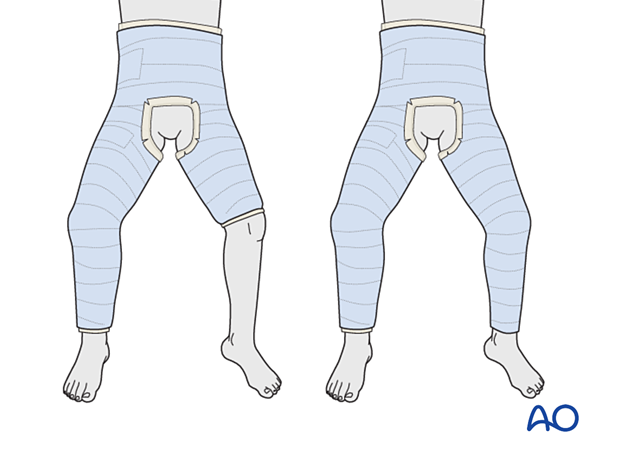Spica casting
1. General considerations
Single-leg, one-and-a-half-leg, or two-leg spica
Whilst a single-leg spica is adequate for most circumstances; some surgeons prefer to extend the cast to the uninjured side as this can help to provide more stability, especially in young children.

Complications
- Loss of reduction
- Compartment syndrome
- Pressure sore
Pitfall: compartment syndrome
It is also important to avoid flexion of the hip and knee beyond 90° as extremes of flexion are associated with an increased risk of compartment syndrome.

2. Material and equipment
Material
- Tubular bandage (stockinette) sized both for leg and for body
- Cast padding
- Felt
- Casting material: fiberglass or plaster of Paris

Equipment
- Hip spica box or table
- Folded towel as abdominal spacer


3. Patient preparation
Read the additional material on preoperative preparation.
Dressing
Cut a generous length of tubular bandage to dress the injured leg and a larger diameter tube for the torso. Tape the two parts of the tubular bandage together to prevent separation of the bandages as the child is moved.
Place the back support for the spica box against the patient's skin underneath the tubular bandage.

Placement on hip spica box
Transfer the anesthetized child onto the hip spica box. Make sure that enough people are available to help positioning and stability.
The child’s sacrum should rest on the back support with its perineum against the padded post. The shoulders should be supported by the spica box leaving almost the entire torso free for casting.
The back support can be secured to the apparatus with tape.

4. Single-leg spica
Dressing
Place a folded towel over the central abdomen, inside the tubular bandage, to create space in the cast for breathing. Bring the tail of the towel towards the neck for ease of removal.

Padding
Apply a layer of cast padding, using a larger width for the body and a narrower one for the leg.
The cast extends from the nipple line, or just below, to just above the malleolus of the ipsilateral ankle.
Consider adding thick felt over the padding at the free edges of the chest and leg.

Cast application
Apply a first layer of cast material to the leg and body sections, taking care to connect leg to body securely, in a figure of eight (spica technique).

Reinforcing slabs of casting material may be applied between the body and leg segments.

Finalizing the cast
Fold the tubular bandage and padding over the edges before applying the final layer of casting material.

Once the cast material is hardened transfer the child from the spica box and remove the abdominal towel and the back support from the cast.
Trim the edges of the cast, to allow flexion of the opposite hip and adequate access to the perineal area.
Consider adding waterproof adhesive tape to the perineal edge of the cast.

Splitting the cast
If the cast around the abdomen has been applied too tightly, split it down the side and spread to allow for expansion or remove and reapply it.

5. One-and-a-half- and two-leg spica
One-and-a-half- and two-leg spicas are applied in the same way as the single-leg spica with the cast, on the contralateral leg, extended to the knee or ankle.
Apply reinforcing slabs of casting material across the hip region of both legs.

Option: bar
Consider the addition of a bar between the two legs to provide more stability to the cast.














